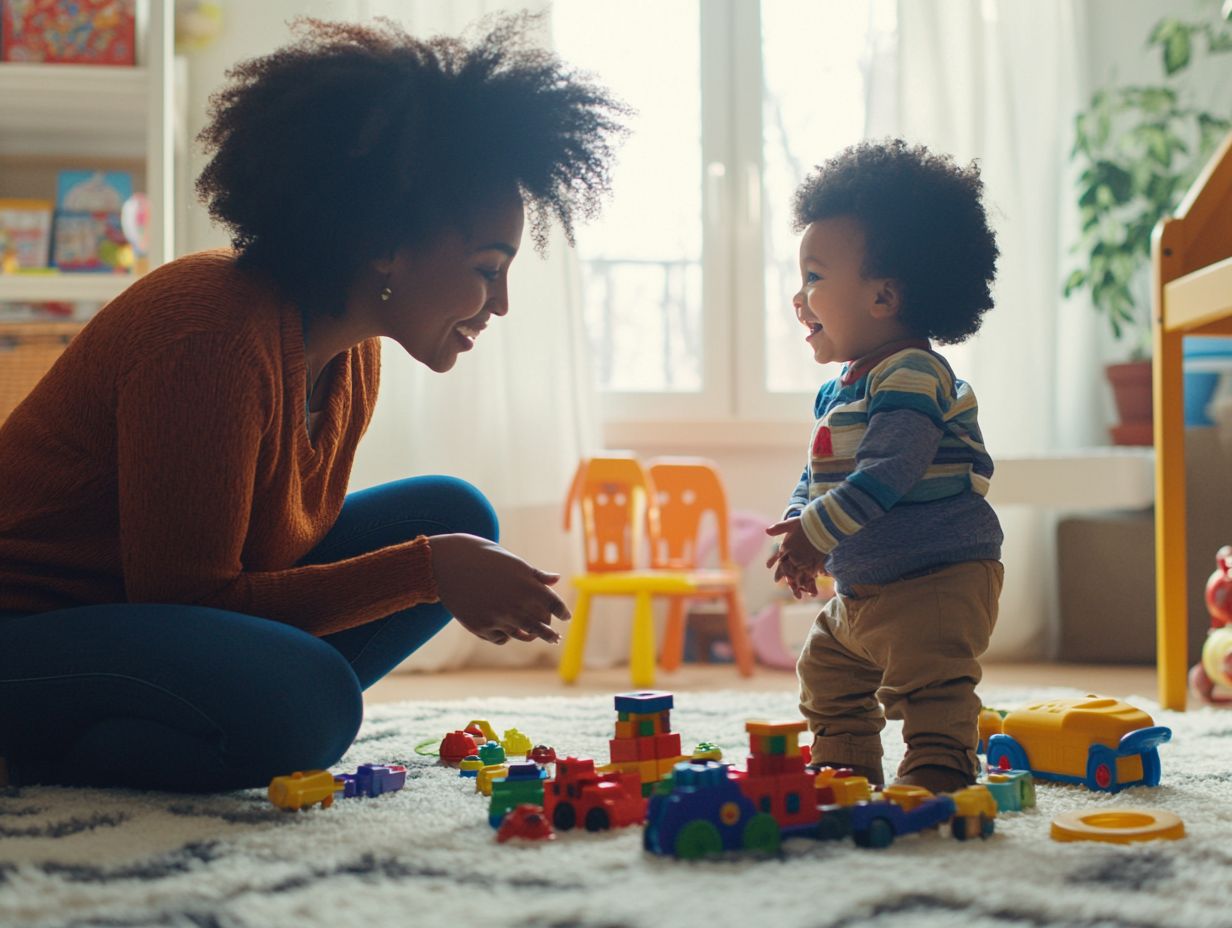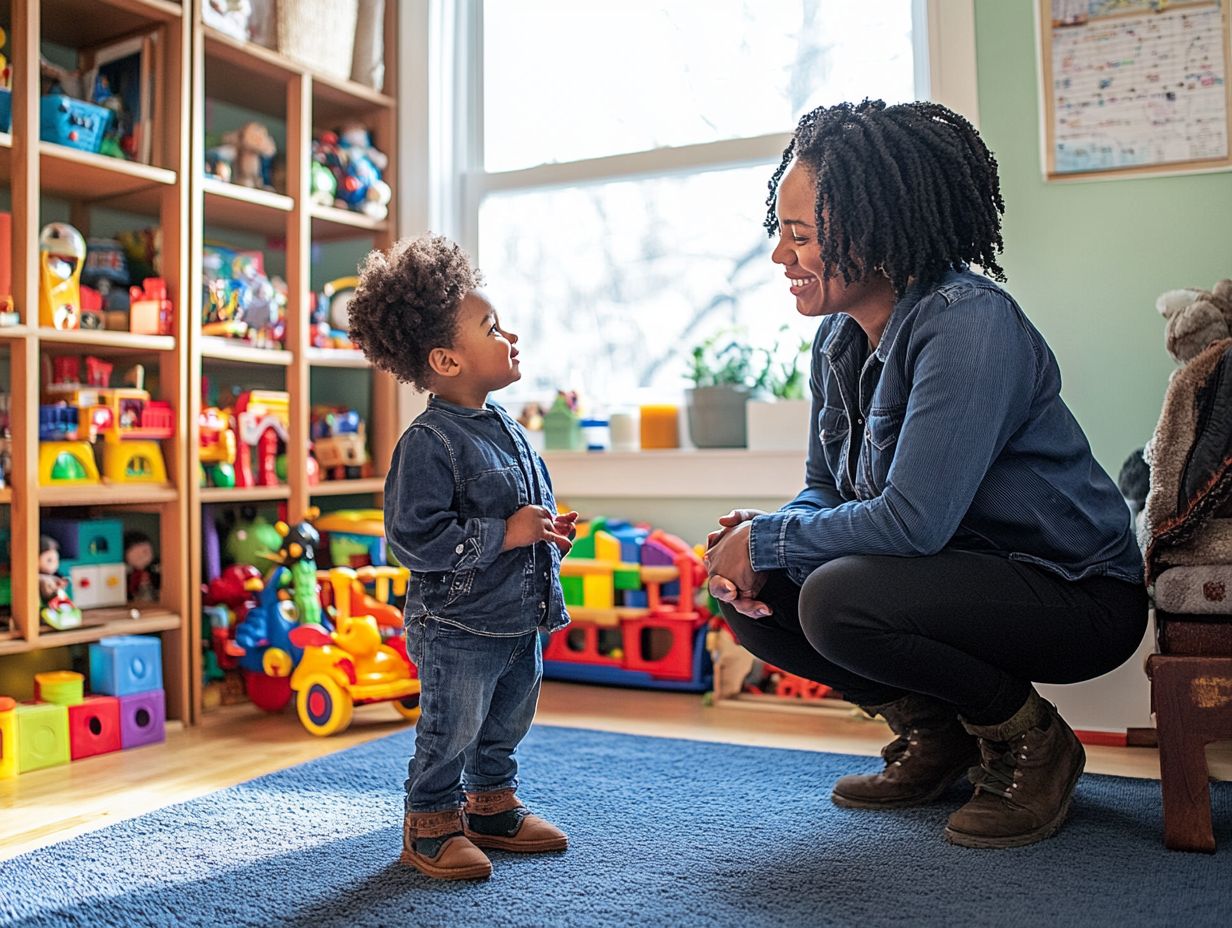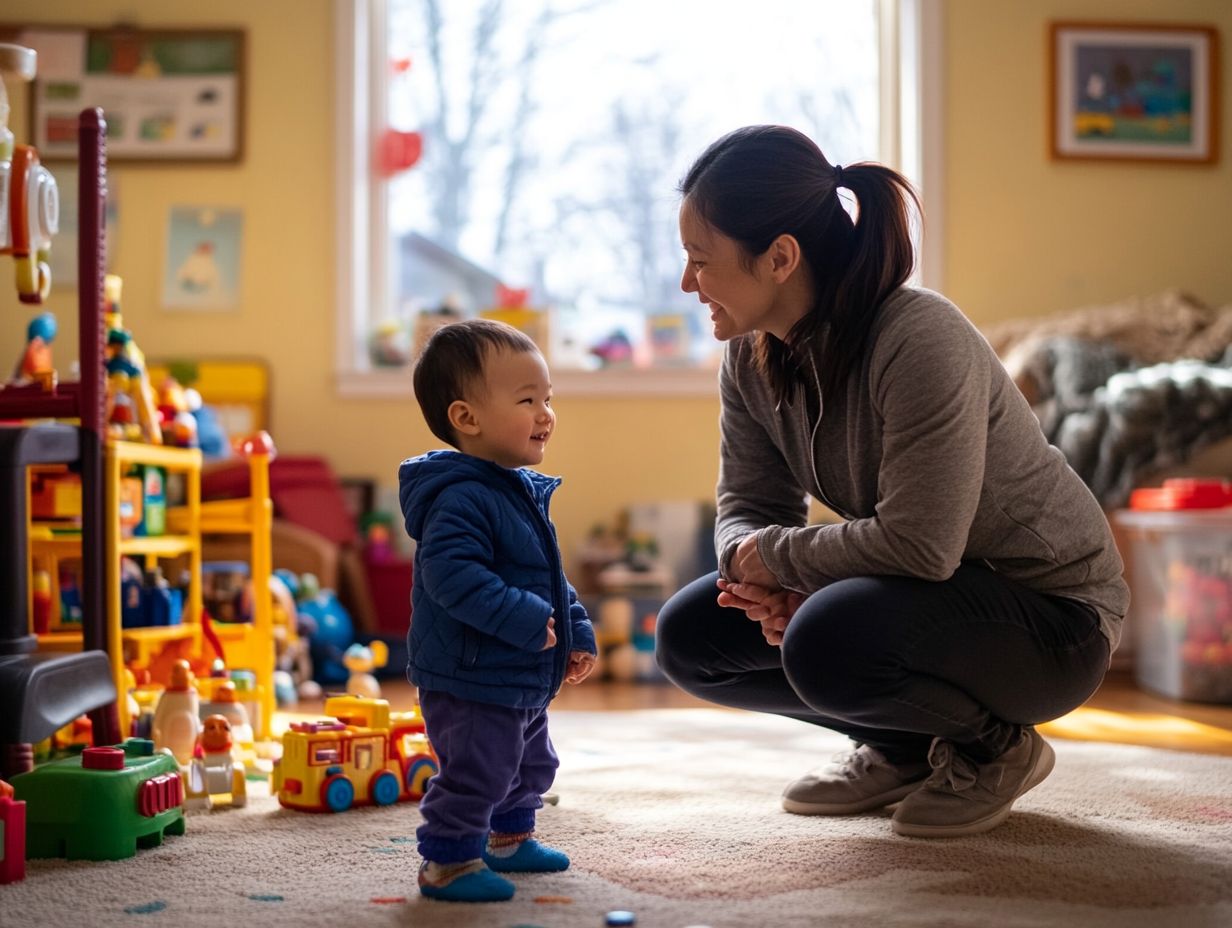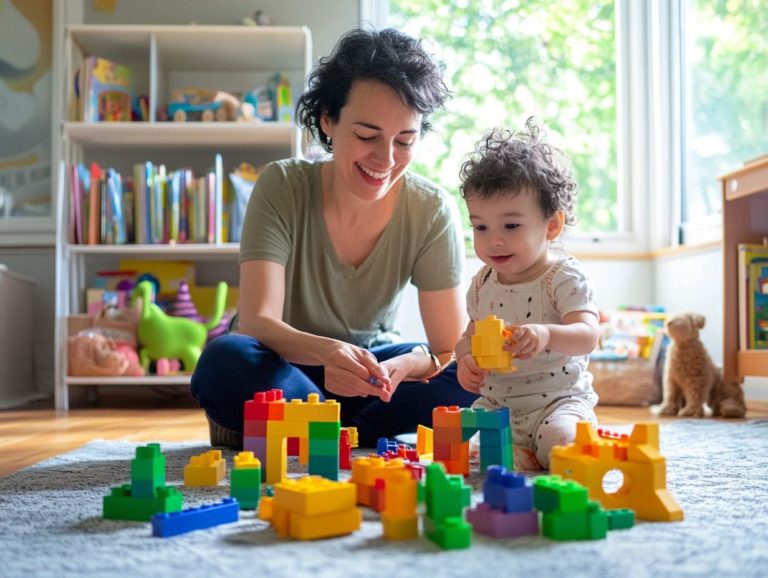The Role of Body Language in Parenting
Understanding the unspoken language of body movements and expressions can truly elevate your relationship with your child.
Body language is a powerful tool in shaping the way you and your child connect and relate to one another. This exploration delves into how you can effectively harness body language to encourage open communication, interpret your child s emotions, and discipline in a positive manner.
By recognizing key cues such as facial expressions, posture, and eye contact, you can strengthen your bond and cultivate a nurturing environment that supports your child’s emotional development and understanding of communication.
Contents
- Key Takeaways:
- The Importance of Body Language in Parenting: Strategies and Tips
- How Can Parents Use Body Language to Communicate Effectively?
- Body Language Cues to Look Out for in Children
- Final Thoughts
- How to Read and Interpret Your Child’s Body Language
- Using Body Language to Discipline Children
- Body Language Strategies for Building a Strong Parent-Child Bond
- 1. Avoid Negative Body Language
- 2. Use Positive Reinforcement
- 3. Model Appropriate Behavior
- Conclusion
- Parenting Tips for Effective Communication
- Frequently Asked Questions
- What is the role of body language in parenting?
- How does body language affect parent-child relationships?
- Can body language influence a child’s behavior?
- What are some common body language cues that parents should be aware of?
- Can parents use body language to discipline their child?
- How can parents improve their body language when interacting with their child?
Key Takeaways:

- Body language plays a crucial role in parent-child relationships, as it can either strengthen or hinder communication.
- As parents, paying attention to your child’s body language cues, such as facial expressions, posture, eye contact, tone of voice, and touch is vital!
- Using positive body language like being present, showing affection, and encouraging open communication can help build a strong bond with your child.
The Importance of Body Language in Parenting: Strategies and Tips
Understanding the significance of body language in parenting is essential for cultivating a nurturing environment that supports healthy child development and effective communication.
Body language serves as a powerful form of communication without words, conveying emotional signals and behavioral cues that enable you to connect with your children on a deeper level. This resembles the principles discussed by experts like Karyn Purvis and Julie-Ann Amos.
By interpreting these body language signs and employing thoughtful communication strategies, you can enhance your relationship with your children and positively influence their emotional intelligence and self-regulation throughout various developmental stages.
Embracing positive body language can greatly improve your family dynamics, ultimately fostering effective discipline and deepening connections within your family. These strategies align with mindful and attentive parenting practices.
How Does Body Language Affect Parent-Child Relationships?
Body language significantly shapes parent-child relationships, conveying emotional signals that often speak volumes beyond words. As a parent, recognize that children, from their very first days as infants to their toddler years, are incredibly attuned to non-verbal cues.
The manner in which you use gestures, facial expressions, and posture is crucial in nurturing trust and understanding. These elements are essential in child psychology and relationship building.
For instance, when you kneel to meet your child at their eye level, it demonstrates your attentiveness and fosters openness and shared joy.
On the flip side, crossed arms or averted gazes can unintentionally signal disinterest or frustration, which may leave your child feeling insecure. Practicing communication in this mindful manner can significantly impact child behavior and emotional regulation.
Embracing positive body language like warm smiles and gentle touches can elevate your child’s emotional well-being and confidence, making them more inclined to express themselves.
In contrast, negative body language can stifle emotional growth, instilling fear or confusion and creating communication barriers that could influence their behavior for years to come. This understanding is vital for effective discipline and fostering confidence.
Start observing and practicing positive body language with your children today, and watch your relationship flourish!
How Can Parents Use Body Language to Communicate Effectively?
You can harness the power of body language to elevate your communication skills, transforming your interactions into something truly effective and meaningful. By using positive body language think open gestures and a calm demeanor you create a supportive environment that encourages your children to express their emotions and needs. Techniques discussed by Deebra Jennings can be instrumental in practicing effective communication.
When you maintain eye contact, you show genuine interest and connection, reinforcing your child s sense of security and importance in the conversation. Using appropriate gestures emphasizes your points and conveys feelings without words, enriching your communication.
Mirroring your child’s non-verbal cues fosters a sense of empathy and understanding, allowing them to feel validated. These techniques help improve emotional understanding and build trust within your relationship, creating a nurturing space where your children feel free to communicate openly.
Body Language Cues to Look Out for in Children
Recognizing body language cues in children is crucial for you as a parent to grasp their emotional states and behavioral patterns. Children convey a wealth of information through their non-verbal signals facial expressions, gestures, posture, and even tone of voice all of which offer valuable insights into their feelings and needs. Understanding these cues can significantly aid in their emotional growth.
By tuning into these nuances, you can foster deeper connections and respond more effectively to your child’s emotional landscape.
1. Facial Expressions
Facial expressions serve as powerful indicators of your child’s emotional state, conveying a range of feelings such as:
- Happiness
- Sadness
- Anger
- Anxiety
By learning to read these emotional signals, you can gain a clearer understanding of your child’s needs and respond in ways that resonate with them. Taking the time to observe these expressions enables you to develop a deeper emotional connection with your little one, fostering a nurturing environment.
For instance, a furrowed brow and pursed lips may suggest frustration, while a wide grin and sparkling eyes typically signify joy. Recognizing these cues allows you to validate your child’s feelings and guide them through various emotional scenarios.
Engaging in open conversations, using gentle tones, and offering physical comfort like hugs can help your child feel understood and secure. By paying attention to these non-verbal signals, you empower your child to express their emotions more effectively as they grow.
2. Posture and Gestures
The way children carry themselves through their posture and gestures communicates a wealth of information about their mood and comfort level. A slumped posture or crossed arms may signal anxiety or discomfort, while open gestures often reflect confidence and ease.
These physical cues also provide insight into their emotional landscape and influence how others perceive them. For example, when a child stands tall and makes eye contact, they typically invite more positive interactions with their peers, fostering a genuine sense of belonging.
As a parent, you play a crucial role in shaping these expressive behaviors. By modeling positive body language like maintaining an upright posture and using welcoming gestures you can encourage your child to adopt similar habits. Reinforcing their confident body language with praise can further solidify these connections, promoting their emotional well-being and healthier social interactions.
Final Thoughts
It’s essential to recognize these body language cues to support your child’s emotional growth! By applying these techniques, you can enhance your communication and build a stronger relationship with your child.
3. Eye Contact

Eye contact is an important part of non-verbal communication. It plays an important role in cultivating emotional intelligence in children, which is the ability to understand and manage feelings. By maintaining appropriate eye contact, you can foster a deeper sense of connection and understanding with your child. This practice is emphasized in childhood psychology and communication skills development.
When you engage in eye contact during conversations, you send a powerful message that your child is valued and heard. This significantly enhances their emotional security. This mutual gaze establishes a foundation of trust and empathy, which is critical for nurturing healthy relationships. This is useful for understanding how infants and toddlers communicate.
To enhance eye contact, consider kneeling to your child’s level. This simple adjustment ensures your eyes meet comfortably, especially during discussions on important or sensitive topics. Incorporating routines like reading together or reflecting on daily experiences while intentionally maintaining eye contact can further strengthen this vital connection. This encouragement allows your child to express their feelings and thoughts with confidence.
4. Tone of Voice
Tone of voice is a crucial element of body language that conveys a wide range of emotions and intentions. It significantly influences how your children interpret messages from you. A warm, calm tone can create a nurturing environment, while a harsh tone might lead to anxiety in your little ones. This understanding is vital for managing anxious behavior effectively.
The way you communicate profoundly impacts your children’s emotional well-being and self-esteem. For instance, when you use a gentle and encouraging tone while providing feedback, you foster a sense of security and open the door to meaningful dialogue. Conversely, a sharp or dismissive tone can evoke feelings of inadequacy and fear, prompting your children to withdraw or misbehave. Such mindful parenting strategies are fundamental in communicating emotions effectively and fostering confidence.
To encourage positive interactions, practice adjusting your vocal inflections. Emphasize warmth and patience, especially during challenging conversations. Consider techniques such as pausing to gather your thoughts before responding. This ensures that your tone harmonizes with the message you wish to convey. This approach nurtures a trusting and supportive parent-child relationship that can last a lifetime. Such efforts can also be supported by reading resources like “The Connected Child,” which delves into effective parental communication.
5. The Power of Touch
Touch serves as a cornerstone of communication. It wields remarkable power in conveying affection, reassurance, and support. Engaging in positive physical interactions like hugs and gentle touches can greatly enrich emotional intelligence in children and fortify family bonds. This is especially important in the early developmental stages of newborns and toddlers.
This profound connection takes root early in life. Infants who experience thoughtful touch from their caregivers are more likely to form secure attachments and develop emotional resilience. Consider how a tender embrace during distress doesn t just soothe a child; it sends a compelling message that they are safe and cherished.
In the everyday rhythm of parenting, consistent skin-to-skin contact during feedings, playful tickles during moments of joy, or simply holding hands on a stroll can nurture these essential connections. Stay alert to your child’s reactions; this awareness is crucial for nurturing your relationship. It’s important to ensure that your interactions are both sensitive and appropriate. This attentiveness fosters trust and love, creating a nurturing environment within your family unit.
How to Read and Interpret Your Child’s Body Language
Reading and interpreting your child’s body language is an invaluable skill that enables you to respond adeptly to their emotional needs. By keenly observing non-verbal cues and grasping the context, you can significantly enhance your ability to offer the right support and guidance.
This not only cultivates emotional regulation in your child but also nurtures their confidence, paving the way for a more harmonious relationship.
1. Observe and Pay Attention
Observing and tuning into a child’s body language is your first step toward grasping their emotional signals and behavioral patterns. Mindful parenting requires you to be present and attuned to the subtle cues that children exhibit, revealing their feelings and needs.
To sharpen your observational skills, embrace active listening. This means not just hearing the words spoken but also paying attention to tone and inflection. Being aware of changes in posture, eye contact, and facial expressions can offer deeper insights into your child’s emotional state. For instance, if your child suddenly withdraws or avoids eye contact, it might signal anxiety or distress. Recognizing these shifts can pave the way for a supportive conversation.
By maintaining a mindful approach, you create an environment where you can fully engage during interactions, fostering a safe space for your child to express themselves openly. This heightened awareness ultimately strengthens emotional connections and enhances communication within your family.
2. Consider Context and Timing
Considering the context and timing of a child’s body language is essential for accurately interpreting their emotional state and behavior. Different situations can provoke diverse responses, so it’s crucial for you to grasp the surrounding factors that influence your child’s silent messages.
Take, for example, a family gathering where your child may display withdrawal and crossed arms, signaling discomfort or shyness. In contrast, during playtime with friends, that same child might light up with excitement and open gestures. Observing these differences allows you to pinpoint underlying feelings and adjust your responses accordingly.
Similarly, a child may appear restless in a classroom due to boredom, but in a more relaxed setting, that same restlessness could indicate a longing for physical activity.
As a caregiver, reflect on the broader environment when assessing emotional signals. Context serves as a lens through which true feelings are revealed, giving you the power to respond with greater understanding and empathy.
3. Ask Open-ended Questions
Asking open-ended questions can be a powerful tool for parents. It encourages children to express their thoughts and feelings, enhancing their communication skills and emotional intelligence.
This method allows your child to share their experiences in a way that reveals their silent messages, offering deeper insights into what they re truly feeling.
By creating an environment where your child feels safe to open up, you can significantly enrich your understanding of their emotional landscape. For instance, instead of the usual, “Did you have a good day at school?” consider asking, “What was the best part of your day at school and why?” This approach invites vibrant and detailed responses!
Encouraging your child to elaborate on their thoughts, perhaps by asking, “How did that make you feel?” can lead to meaningful conversations. These discussions help your child learn to navigate their emotional world and articulate their feelings with greater clarity, transforming everyday interactions into opportunities for growth and connection.
Using Body Language to Discipline Children

Utilizing body language effectively can be instrumental in your discipline approach, enabling you to send messages without causing conflict or fostering misunderstandings.
By adopting positive body language and steering clear of negative cues, you can cultivate a more constructive atmosphere that supports effective discipline.
Body Language Strategies for Building a Strong Parent-Child Bond
Implementing effective body language strategies can profoundly enhance the bond between you and your child. These strategies foster emotional intelligence and encourage open communication.
By being mindful of your own body language and attuned to your child’s non-verbal cues, you can cultivate a nurturing environment that deepens understanding and connection.
1. Avoid Negative Body Language
Avoiding negative body language is essential for maintaining a positive disciplinary approach. Negative body language can unintentionally signal disapproval or frustration to a child. You should be mindful of your non-verbal cues and strive to present a calm and composed demeanor during critical disciplinary moments.
For instance, crossed arms or a furrowed brow might signify anger or discontent. This can prompt children to feel defensive instead of open to guidance. Such reactions can breed resentment and diminish the chances of productive conversations about behavior.
Instead, consider adopting open body postures, maintaining eye contact, and using gentle gestures to convey understanding and support. Practicing mindfulness techniques can help you recognize when negative emotions begin to surface, allowing for more controlled and thoughtful responses.
By consciously managing your body language, you can create a nurturing environment that encourages positive behavior and fosters healthy communication.
2. Use Positive Reinforcement
Incorporating positive reinforcement through body language can significantly enhance your discipline strategies. This encourages the desired behaviors in your children. Simple gestures, like a nod or a smile, can reinforce positive actions and cultivate an environment filled with emotional support.
When you observe your children making good choices, consider amplifying this positive reinforcement with non-verbal cues. A thumbs-up or a gentle pat on the back not only celebrates their accomplishments but also communicates your approval without uttering a single word.
Maintaining eye contact while discussing their positive behaviors fosters a sense of connection and understanding. Using body language, such as open arms and an inviting posture, can further encourage your children to feel safe and valued, making them more receptive to your guidance and feedback.
3. Model Appropriate Behavior
Modeling appropriate behavior through body language is an effective way to teach children how to communicate and interpret emotional signals. By exemplifying positive body language, you set a standard for your children to follow. This nurtures their emotional intelligence and self-regulation.
When you demonstrate openness through gestures, maintain eye contact, and use facial expressions that align with your words, you highlight the significance of non-verbal cues in communication. Encouraging your children to express their feelings while validating their emotions creates an environment where emotional literacy can truly thrive.
Practicing active listening without distractions reinforces the idea that their thoughts and feelings hold value. This approach allows children to observe and emulate the appreciation of empathy and respect fundamental elements for cultivating healthy relationships.
Ultimately, when you embody these practices, you not only impart invaluable skills but also strengthen the bond you share with your children.
Conclusion
By implementing these body language strategies, you can enhance your relationship with your child. Take the time to practice these techniques in your daily interactions. Doing so will nurture emotional intelligence and encourage open communication, leading to a stronger parent-child bond.
Parenting Tips for Effective Communication
1. Be Present and Engaged
Being present and fully engaged during interactions with children is crucial. It fosters deep connections and effective communication.
Active participation in your child s life, using attentive body language, creates a nurturing environment. This environment promotes a sense of security and emotional support.
Focus on your child’s words and feelings. Ask open-ended questions and validate their emotions.
For example, when your child shares a story, maintaining eye contact and nodding encourages them to express themselves.
Positive body language, such as smiling and leaning in, helps your child feel valued and understood. This is essential for attentive parenting and relationship building.
Engaging in activities like reading, playing games, or cooking creates wonderful opportunities for deeper interaction. These moments enhance communication and listening skills.
Such activities promote better understanding of developmental stages and child behavior.
2. Show Affection and Support
Expressing affection and support through body language strengthens emotional bonds. It promotes emotional intelligence and a sense of safety.
Simple gestures like hugs, pats, or warm smiles convey love and encouragement. Non-verbal communication is key to understanding emotional signals.
Nonverbal cues nurture relationships, helping children understand feelings of acceptance. A gentle touch or holding hands during tough moments reassures them they are not alone.
This fosters resilience and emotional growth, as recommended by experts like Karyn Purvis and HealthPark Pediatrics.
Consistent displays of affection, such as cuddling or sharing laughs, improve emotional wellbeing. Such actions significantly contribute to child development, fostering confidence and understanding of needs.
Supportive gestures not only enhance communication but also create an environment where children feel valued. This contributes to their social development and emotional health.
These tips are essential for mindful parenting.
3. Encourage Open Communication

Encouraging open communication through body language nurtures a healthy relationship. Positive reinforcement and attentive non-verbal cues create a secure environment for your child.
This atmosphere of trust is enhanced by mirroring your child’s emotions. Validating their experiences shows their feelings are acknowledged.
Soft eye contact, nods of understanding, and an open posture invite dialogue. These reinforce emotional intelligence and deepen connections.
Encouraging children to express their feelings cultivates vital emotional skills. This practice fosters empathy and helps navigate challenges together.
Strengthening your bond over time is essential in child psychology and effective communication.
4. Respect Boundaries
Respecting boundaries is fundamental in parenting. Your body language plays a pivotal role in conveying respect for your child’s personal space and emotional signals. By understanding when to step back or when to engage, you can cultivate a sense of autonomy and confidence in your children.
This principle is emphasized in strategies for childhood anxiety and attachment styles.
When you are attuned to your child’s nonverbal cues like crossed arms or a step back you send a clear message that you recognize and honor their boundaries. This acknowledgment empowers them to feel safe and valued! Such mutual respect forms the foundation for healthy emotional development, giving children the power to express themselves freely without the fear of being dismissed or overstepped.
Deebra Jennings and Safe Families Program stress the importance of understanding signals and indications.
Your open and inviting demeanor can foster dialogue, reassuring your children that their feelings and preferences truly matter. Nurturing an environment where boundaries are honored lays the groundwork for stronger, more trusting relationships. This enables your children to navigate their own interactions with others as they grow, which is essential in building family dynamics and connection building.
Frequently Asked Questions
What is the role of body language in parenting?
Body language plays a significant role in parenting as it can convey emotions, establish boundaries, and build a connection with your child. It is also vital for understanding infant cues and toddler signs.
How does body language affect parent-child relationships?
Positive body language, such as maintaining eye contact and using open gestures, can improve parent-child relationships by promoting trust and understanding. Julie-Ann Amos and The Connected Child highlight the importance of these practices in child development.
Can body language influence a child’s behavior?
Yes, body language can influence a child’s behavior. For example, standing with arms crossed and a stern facial expression can signal disapproval, discouraging certain behaviors. Conversely, positive gestures like smiling can encourage self-regulation in children.
What are some common body language cues that parents should be aware of?
Facial expressions, posture, and tone of voice are some common body language cues that parents should pay attention to when communicating with their child. Being aware of behavioral patterns and nurturing signals can further enhance the parent-child bond.
Can parents use body language to discipline their child?
Body language can be a helpful tool for disciplining a child, but it should be used in conjunction with clear verbal communication and consistent consequences. This approach is advocated by Singapore and pediatrician experts.
How can parents improve their body language when interacting with their child?
Practicing active listening, maintaining an open and relaxed posture, and being aware of nonverbal cues can help parents improve their body language when interacting with their child. Understanding body language signs and physical gestures can enhance supportive communication.
Explore more tips on strengthening your parenting approach!






